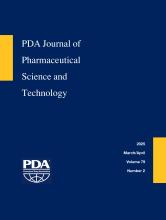Abstract
Challenges in the manufacturing of high-concentration antibody formulations have seldom been discussed. These are observed mainly from late downstream operations where the antibody gets concentrated to its final strength to final fill finish processing and containerization of the product. The present paper summarizes the challenges typically observed in manufacturing and processing of high-concentration antibody products and provides turnkey solutions to these typical challenges in order to have a consistent and robust manufacturing process for these products. Immunoglobulin G1 (IgG1) has been used as a model protein for studying the challenges and providing solutions to them. The late downstream challenges, like increased viscosity limiting further concentration, can be resolved by use of viscosity modifying agents in the formulation. Replacement of the conventionally used ‘A’ screen membranes with ‘D’ screen or using single pass tangential flow filtration can further provide an in targeting higher concentrations for the same protein with lesser shear and aggregation. Using a 0.5 µm/0.2 µm asymmetric or bilayered membrane instead of the conventional 0.2 µm membrane resulted in better flux during filtration of a high-concentration IgG1 formulation. In-process holding time during the filling operation was optimized to be <60 min based on the nozzle drying time for the high-concentration IgG1 formulation. An appropriate control strategy of replacing filling nozzles and performing periodic fill weight checks was proposed for the fill-finish process of a high-concentration IgG1 formulation.
- Ultra-high concentration
- Low-viscosity
- Antibody formulation
- Tangential flow filtration
- Cryo-concentration
- Sterile filtration
- Fill-finish processing
- © PDA, Inc. 2025
PDA members receive access to all articles published in the current year and previous volume year. Institutional subscribers received access to all content. Log in below to receive access to this article if you are either of these.
If you are neither or you are a PDA member trying to access an article outside of your membership license, then you must purchase access to this article (below). If you do not have a username or password for JPST, you will be required to create an account prior to purchasing.
Full issue PDFs are for PDA members only.
Note to pda.org users
The PDA and PDA bookstore websites (www.pda.org and www.pda.org/bookstore) are separate websites from the PDA JPST website. When you first join PDA, your initial UserID and Password are sent to HighWirePress to create your PDA JPST account. Subsequent UserrID and Password changes required at the PDA websites will not pass on to PDA JPST and vice versa. If you forget your PDA JPST UserID and/or Password, you can request help to retrieve UserID and reset Password below.






